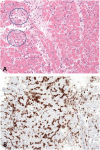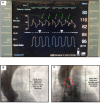Case Report First-in-Man Method Description: Left Ventricular Unloading With iVAC2L During Veno-Arterial Extracorporeal Membrane Oxygenation: From Veno-Arterial Extracorporeal Membrane Oxygenation to ECMELLA to EC-iVAC®
- PMID: 33102536
- PMCID: PMC7545402
- DOI: 10.3389/fcvm.2020.563448
Case Report First-in-Man Method Description: Left Ventricular Unloading With iVAC2L During Veno-Arterial Extracorporeal Membrane Oxygenation: From Veno-Arterial Extracorporeal Membrane Oxygenation to ECMELLA to EC-iVAC®
Abstract
Veno-arterial extracorporeal membrane oxygenation (V-A ECMO) is increasingly used in bi-ventricular failure with cardiogenic shock to maintain systemic perfusion. Nonetheless, it tends to increase left ventricular (LV) afterload and myocardial oxygen demand. In order to mitigate these negative effects on the myocardium, an Impella CP® (3.5 L/min Cardiac Output) can be used in conjunction with V-A ECMO (ECMELLA approach). We implemented this strategy in a patient with severe acute myocarditis complicated by cardiogenic shock. Due to a hemolysis crisis, Impella CP® had to be substituted with PulseCath iVAC2L®, which applies pulsatile flow to unload the LV. A subsequent improvement in LV systolic function was noted, with increased LV ejection fraction (LVEF), LV end-diastolic diameter (LVEDD) reduction, and a reduction in plasma free hemoglobin. This case documents the efficacy of iVAC2L in replacing Impella CP as a LV vent during V-A ECMO, with less hemolysis.
Keywords: ECMO; IVAC; Impella; heart failure; mechanical circulatory support; mechanical unloading.
Copyright © 2020 Tschöpe, Alogna, Faragli, Klingel, Schmidt, Heilmann, B Bastos and Spillmann.
Figures



Similar articles
-
Case report: Refractory cardiac arrest supported with veno-arterial-venous extracorporeal membrane oxygenation and left-ventricular Impella CP®-Physiological insights and pitfalls of ECMELLA.Front Cardiovasc Med. 2022 Nov 4;9:1045601. doi: 10.3389/fcvm.2022.1045601. eCollection 2022. Front Cardiovasc Med. 2022. PMID: 36407456 Free PMC article.
-
Cardiogenic shock with highly complicated course after influenza A virus infection treated with vva-ECMO and Impella CP (ECMELLA): a case report.BMC Cardiovasc Disord. 2021 Nov 8;21(1):528. doi: 10.1186/s12872-021-02346-2. BMC Cardiovasc Disord. 2021. PMID: 34743690 Free PMC article.
-
Haemodynamic implications of VA-ECMO vs. VA-ECMO plus Impella CP for cardiogenic shock in a large animal model.ESC Heart Fail. 2024 Aug;11(4):2305-2313. doi: 10.1002/ehf2.14780. Epub 2024 Apr 22. ESC Heart Fail. 2024. PMID: 38649295 Free PMC article.
-
Impella as unloading strategy during VA-ECMO: systematic review and meta-analysis.Rev Cardiovasc Med. 2021 Dec 22;22(4):1503-1511. doi: 10.31083/j.rcm2204154. Rev Cardiovasc Med. 2021. PMID: 34957789
-
Left ventricular unloading during veno-arterial ECMO: a review of percutaneous and surgical unloading interventions.Perfusion. 2019 Mar;34(2):98-105. doi: 10.1177/0267659118794112. Epub 2018 Aug 16. Perfusion. 2019. PMID: 30112975 Free PMC article. Review.
Cited by
-
Venting during venoarterial extracorporeal membrane oxygenation.Clin Res Cardiol. 2023 Apr;112(4):464-505. doi: 10.1007/s00392-022-02069-0. Epub 2022 Aug 20. Clin Res Cardiol. 2023. PMID: 35986750 Free PMC article. Review.
-
Percutaneous Mechanical Circulatory Support in Acute Heart Failure Complicated with Cardiogenic Shock.J Clin Med. 2024 Apr 30;13(9):2642. doi: 10.3390/jcm13092642. J Clin Med. 2024. PMID: 38731171 Free PMC article. Review.
-
The "TIDE"-Algorithm for the Weaning of Patients With Cardiogenic Shock and Temporarily Mechanical Left Ventricular Support With Impella Devices. A Cardiovascular Physiology-Based Approach.Front Cardiovasc Med. 2021 Feb 19;8:563484. doi: 10.3389/fcvm.2021.563484. eCollection 2021. Front Cardiovasc Med. 2021. PMID: 33681302 Free PMC article.
-
Effectiveness and Safety of a Prolonged Hemodynamic Support by the IVAC2L System in Healthy and Cardiogenic Shock Pigs.Front Cardiovasc Med. 2022 Feb 8;9:809143. doi: 10.3389/fcvm.2022.809143. eCollection 2022. Front Cardiovasc Med. 2022. PMID: 35211526 Free PMC article.
References
Publication types
LinkOut - more resources
Full Text Sources
Miscellaneous

